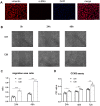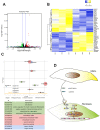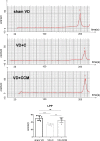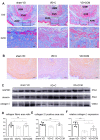Bone marrow stem cells secretome accelerates simulated birth trauma-induced stress urinary incontinence recovery in rats
- PMID: 33793419
- PMCID: PMC8064190
- DOI: 10.18632/aging.202812
Bone marrow stem cells secretome accelerates simulated birth trauma-induced stress urinary incontinence recovery in rats
Abstract
Stress urinary incontinence (SUI) is defined as involuntary urine leakage during physical activities that increase the intra-abdominal pressure on the bladder. We studied bone marrow stem cell (BMSC) secretome-induced activation of anterior vaginal wall (AVW) fibroblasts and its ability to accelerate SUI recovery following vaginal distention (VD) in a rat model of birth trauma using BMSC-conditioned medium (BMSC-CM) and concentrated conditioned medium (CCM). BMSC-CM enhanced the proliferation, migration, and collagen synthesizing abilities of fibroblasts. Differentially expressed genes in BMSC-CM-induced fibroblasts were mainly enriched for cell adhesion, extracellular fibril organization and angiogenesis. Treatment with the JAK2 inhibitor AG490 reversed BMSC-CM-induced activation of the JAK2/STAT4 pathway. Periurethral injection with BMSC-CCM markedly enhanced the abdominal leak point pressure (LPP) in rats after VD. Histological analysis revealed increased numbers of fibroblasts, improved collagen fibers arrangement and elevated collagens content in the AVW of rats receiving BMSC-CCM. These findings suggest the BMSC secretome activates AVW fibroblasts and contributes to the functional and anatomic recovery of simulated birth trauma-induced SUI in rats.
Keywords: JAK2/STAT4; bone marrow stem cells; fibroblasts; secretome; stress urinary incontinence.
Conflict of interest statement
Figures







Similar articles
-
Progress of mesenchymal stem cells affecting extracellular matrix metabolism in the treatment of female stress urinary incontinence.Stem Cell Res Ther. 2025 Feb 25;16(1):95. doi: 10.1186/s13287-025-04220-w. Stem Cell Res Ther. 2025. PMID: 40001265 Free PMC article. Review.
-
Rat mesenchymal stem cell secretome promotes elastogenesis and facilitates recovery from simulated childbirth injury.Cell Transplant. 2014;23(11):1395-406. doi: 10.3727/096368913X670921. Epub 2013 Jul 17. Cell Transplant. 2014. PMID: 23866688 Free PMC article.
-
Mesenchymal stem cells and their secretome partially restore nerve and urethral function in a dual muscle and nerve injury stress urinary incontinence model.Am J Physiol Renal Physiol. 2015 Jan 15;308(2):F92-F100. doi: 10.1152/ajprenal.00510.2014. Epub 2014 Nov 5. Am J Physiol Renal Physiol. 2015. PMID: 25377914 Free PMC article.
-
Secretomes of human pluripotent stem cell-derived smooth muscle cell progenitors upregulate extracellular matrix metabolism in the lower urinary tract and vagina.Stem Cell Res Ther. 2021 Apr 6;12(1):228. doi: 10.1186/s13287-021-02292-y. Stem Cell Res Ther. 2021. PMID: 33823931 Free PMC article.
-
Hypoxia conditioning enhances neuroprotective effects of aged human bone marrow mesenchymal stem cell-derived conditioned medium against cerebral ischemia in vitro.Brain Res. 2019 Dec 15;1725:146432. doi: 10.1016/j.brainres.2019.146432. Epub 2019 Sep 3. Brain Res. 2019. PMID: 31491422 Review.
Cited by
-
Cellular regenerative therapy in stress urinary incontinence: new frontiers?-a narrative review.Transl Androl Urol. 2024 Aug 31;13(8):1709-1716. doi: 10.21037/tau-22-682. Epub 2023 Jul 24. Transl Androl Urol. 2024. PMID: 39280677 Free PMC article. Review.
-
Perinatal mesenchymal stromal cells of the human decidua restore continence in rats with stress urinary incontinence induced by simulated birth trauma and regulate senescence of fibroblasts from women with stress urinary incontinence.Front Cell Dev Biol. 2023 Jan 18;10:1033080. doi: 10.3389/fcell.2022.1033080. eCollection 2022. Front Cell Dev Biol. 2023. PMID: 36742196 Free PMC article.
-
Mesenchymal stem cell-based therapy for female stress urinary incontinence.Front Cell Dev Biol. 2023 Jan 13;11:1007703. doi: 10.3389/fcell.2023.1007703. eCollection 2023. Front Cell Dev Biol. 2023. PMID: 36711031 Free PMC article. Review.
-
Progress of mesenchymal stem cells affecting extracellular matrix metabolism in the treatment of female stress urinary incontinence.Stem Cell Res Ther. 2025 Feb 25;16(1):95. doi: 10.1186/s13287-025-04220-w. Stem Cell Res Ther. 2025. PMID: 40001265 Free PMC article. Review.
-
Impact of internet plus health education on urinary stoma caregivers in coping with care burden and stress in the era of COVID-19.Front Psychol. 2022 Nov 30;13:982634. doi: 10.3389/fpsyg.2022.982634. eCollection 2022. Front Psychol. 2022. PMID: 36532976 Free PMC article.
References
Publication types
MeSH terms
Substances
LinkOut - more resources
Full Text Sources
Other Literature Sources
Medical
Miscellaneous

